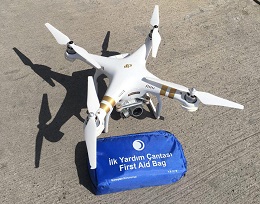13 August 2019
 Drones, smartphones and sensors could provide a lifeline to the world’s growing elderly population at risk of falls, helping to cut global hospital costs.
Drones, smartphones and sensors could provide a lifeline to the world’s growing elderly population at risk of falls, helping to cut global hospital costs.
A new system has been designed by a team of researchers from Iraq and the University of South Australia to remotely monitor elderly people, detecting abnormalities in their heart rate and temperature which can lead to falls, and provide urgent first aid via a drone if a fall occurs.
UniSA Adjunct Senior Lecturer Dr Ali Al-Naji and Professor Javaan Chahl are working with Dr Sadik Kamel Gharghan and Saif Saad Fakhrulddin from Baghdad’s Middle Technical University to develop an advanced fall detection and first aid system for the elderly.
In a new paper published in Sensors, the researchers describe how a wearable device can monitor vital signs using a wireless sensor attached to the upper arm and send a message to an emergency call centre if physiological abnormalities or a fall are detected.
“When a case is critical, first aid supplies can be delivered to the patient and their carer via a drone, up to 105 seconds faster than an ambulance,” according to Prof Chahl.
“The system not only correctly measures heart rate and falls with 99 per cent accuracy, but also identifies the elderly person’s location and delivers first aid much faster.”
“We have also designed an advanced smartphone-based program that uses an intelligent autopilot, containing a destination waypoint for planning the path of a drone,” says Dr Gharghan.
The fall detection device consists of a microcontroller, two bio-sensors, a GPS module to track the location and a GSM module to send a notification to the smartphones of caregivers. The second part includes a first aid package, a smartphone and a drone to deliver the package.
It is estimated that around 30 per cent of adults over the age of 65 experience at least one fall a year, in many cases fracturing a hip, or sustaining head injuries.
The annual global cost of fall-related acute care for older people has risen dramatically in recent years as the world’s population ages. In Australia, the annual cost exceeds $600 million, and this figure blows out to billions of dollars each year in the United States and other parts of the world.
The most recent figures show that falls account for 40 per cent of injury-related deaths and one per cent of total deaths in people aged over 65 years.
For a copy of the paper (https://www.mdpi.com/1424-8220/19/13/2955), or for more information about the study, please contact sadik.gharghan@mtu.edu.iq or Ali.Al-Naji@unisa.edu.au
Additional notes
The project was undertaken in Iraq by Saif Saad Fakhrulddin, Professor Sadik Kamel Gharghan and Dr Ali Al-Naji, all academic staff based at Baghdad’s Electrical Engineering Technical College at Baghdad’s Middle Technical University. Javaan Chahl is a Professor of Sensor Systems at UniSA’s School of Engineering.
Media contact: Candy Gibson office +61 8 8302 0961 mobile: +61 434 605 142
email: candy.gibson@unisa.edu.au




